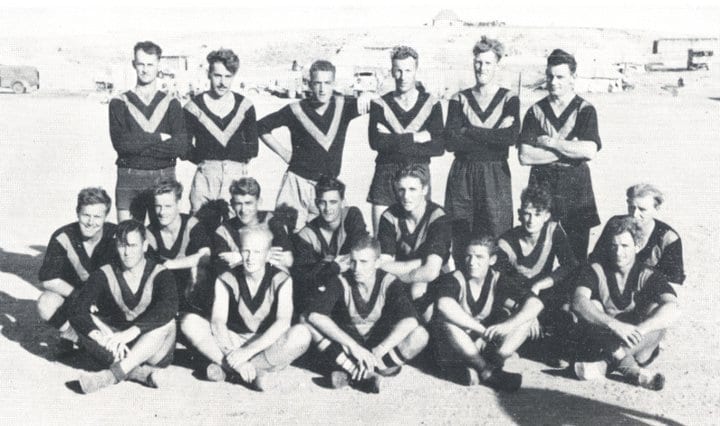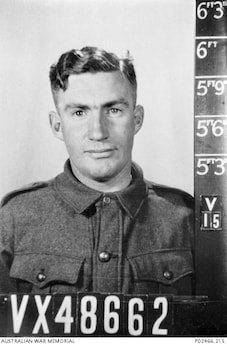This year marks 80 years since the start of the Second World War. The years have marched on and fewer people now have living memory of this conflict, or of the dozens of Hawthorn players who fought in it. Jack Drake and Gus Young played in the brown & gold as Mayblooms. Intervening years have seen their names largely fade from thought. Both players were caught up in a campaign that was, ultimately, a futile attempt to stop the 1941 German onslaught in Greece and the neighbouring island of Crete.
John Montague ‘Jack’ Drake was born in Perth in 1905. One of six children, he moved with his family to the Hawthorn district as a boy. Recruited to the Club from Old Xaverians, Drake made his senior debut against Fitzroy as a centre half forward in Round 7, 1926. Wearing guernsey number 23, Drake would kick his only goal for Hawthorn during that first game. An injury suffered in his debut would curtail his season. Two further games would follow. But, even with some favourable newspaper reports of his play, his League career would not see another year.
He chose a legal career and returned to play amateur football with Old Xaverians. By 1939 he was an articled clerk in a firm of solicitors. Drake enlisted in the AIF in December 1939. He became a gunner in the 2 / 2 Field Regiment artillery, part of the Australian 6th Division. Raised at the Melbourne Showgrounds in October 1939, his unit then served in Palestine and North Africa, seeing action in early 1941 at Bardia, Derna and Barce.

Thermopylae is a name that has echoed from antiquity. The battle that raged there in 480BC brought everlasting fame to the small Greek force, including the 300 Spartans who fought to the end guarding its narrow coastal pass against overwhelming odds. In April 1941, this place would again be the scene of heroic last actions. A vastly outnumbered force as the Greek army - overwhelmed by the invasion by 28 German divisions - was withdrawn to the Thermopylae Line. British and Commonwealth forces helped hold the Line. A large segment of the Australian 6th Division was involved in this defence. Some of these Australians would help thousands of Allied troops evacuate from this disastrous campaign.
Jack Drake was part of a small crew from ‘A Troop’ manning two field guns in a forward position, placed precariously on the slopes overlooking Brallos Pass. They were there to prevent German sappers from repairing bridges across the pass and movement along the main road. But they were in full view of German artillery. They stayed in this position for over 30 hours, supporting Australian and New Zealand infantry, maintaining a rate of fire that kept the enemy tied down. Two battalions of the Anzac Corps would eventually escape to Crete and Egypt, thanks to these actions.
Drake would not be among them. On April 23, after the Australians were ordered to evacuate, German artillery hit his position, taking out the guns, instantly killing several gunners and wounding others. Drake was hit, losing both legs below the knee. His wounds would prove fatal. Lance Bombardier Drake is buried in the Phaleron War Cemetery, Athens.
.jpg)
Leo ‘Gus’ Young was born in Heyfield, Victoria in 1915. Recruited to Hawthorn following a successful junior career with Maffra, Young was a noted high-marking forward. The Gippsland Times wrote that he worked as a butcher and had developed into a ‘fine specimen of manhood.’ He played his first game in Round 13, 1939 against North Melbourne. The Herald mentioned that he had made ‘a good debut.’ Wearing number 21, he would play a total of 10 games for Hawthorn, kicking 5 goals. He played his final game against Collingwood in Round 11, 1940.
He served in the militia before the war. Training first with a local battalion in Gippsland, Young transferred to the 37/39th Battalion (Hawthorn-Kew Regiment) when he joined the Mayblooms in 1939. Enlisting in the AIF in August 1940, Young became a member of the 7th Battery, 2/3 Light Anti-Aircraft Regiment. The unit was sent to Crete to help defend the Royal Air Force base at Heraklion in 1941. Young would see action as part of a Bofors gun crew.
Crete also provided the next stop for many of the troops evacuated from the Greek mainland. A garrison of Greek, British and ANZAC troops dug in, defending the civilian population and newly-built RAF airfields. The Germans soon followed, invading the island on May 20 with paratroopers landing at four different points, including Heraklion. Dozens of German planes dotted the skies above the island, providing many targets for the gunners. Gus Young’s battery was in the midst of the fight, helping to blunt this initial airborne attack.

Whilst a promising fight at the start, the island’s difficult terrain led to problems with supply and communication as more and more German troops arrived. There were also brutal German reprisals against local Cretans who aided the Allies. Evacuation proved a necessity as the Allied garrison was eventually pushed further to the south. Troops started to evacuate to Egypt from May 28. Some, though, stayed behind, joining locals to continue the fight in a vicious guerrilla campaign. Many others would be captured.
Young and his unit were evacuated by the destroyer, HMS Hereward on May 29. They were not safe. The ship was attacked and sunk by Stuka dive bombers as it steamed around the island’s coast. Most of the Australians aboard were rescued by Italian navy ships. Bombardier Gus Young, though, was one of 48 killed. Originally listed as ‘missing’, his body was never found. He is remembered at the Athens Memorial, Greece and on panel 21 of the Australian War Memorial’s Commemorative Area.
Unfortunately, Gus Young is still on our list of Missing Hawks. Our knowledge of his time at Hawthorn is limited and his army pay-book photo is the only image we have. Almost 80 years on, the campaigns these soldiers fought may seem futile, their loss a waste. This shouldn’t limit our gratitude for the sacrifice made by Hawthorn players such as Jack Drake and Gus Young. Their courage in standing up against overwhelming odds should never be forgotten. Drake, Young and the 16 other Hawthorn players who made the ultimate sacrifice are remembered in the War Service Cabinet in the Hawks Museum.
If you have further information, or photos of Jack Drake or Gus Young, please contact the Hawks Museum on (03) 9535 3075 or email us at hawksmuseum@hawthornfc.com.au




